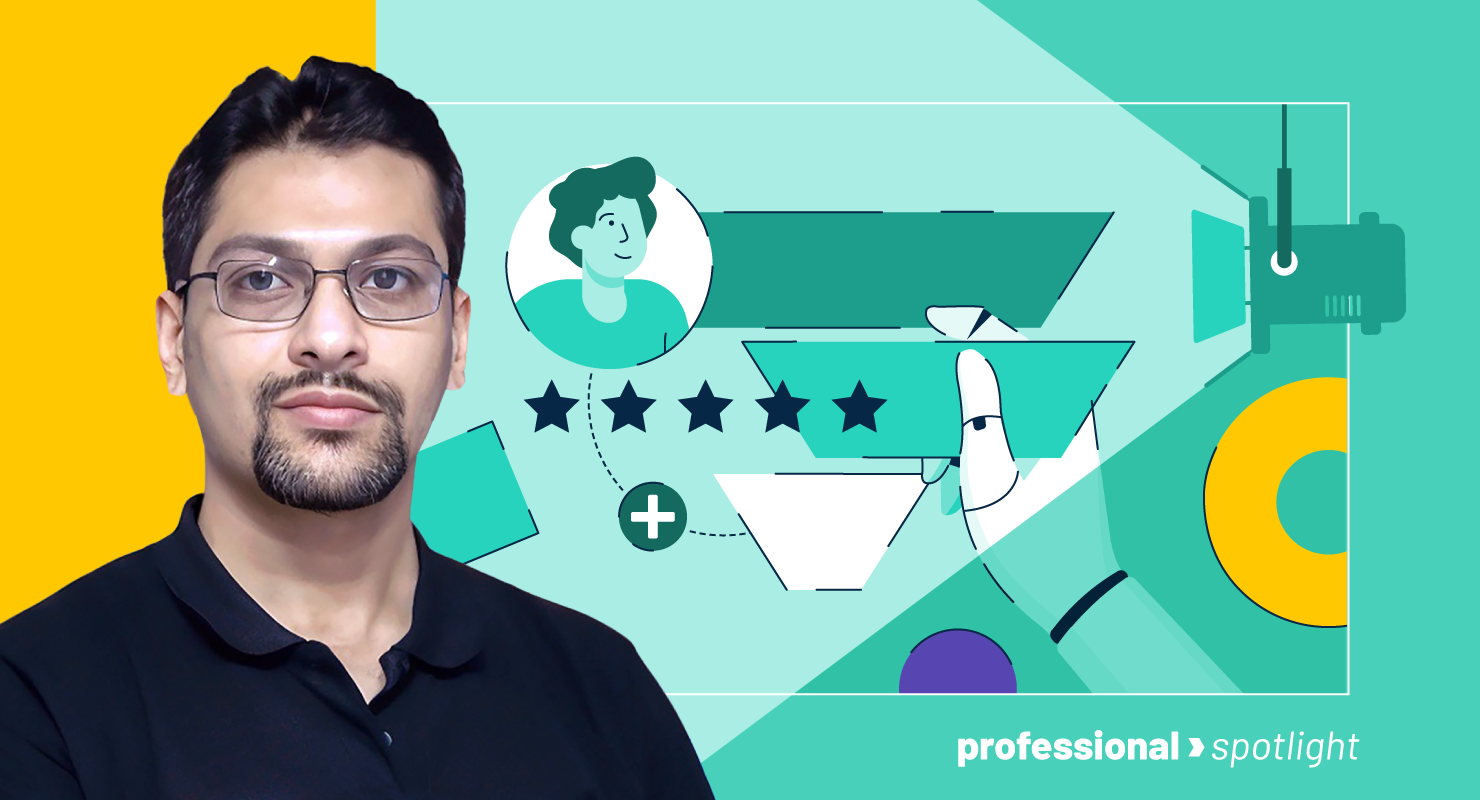August 28, 2024
 by Kamaljeet Kalsi / August 28, 2024
by Kamaljeet Kalsi / August 28, 2024

Jeffrey Gitomer, author of "The Sales Bible," famously said, "Great salespeople are relationship builders who provide value and help their customers win."
Fast forward to 2024, and the modern sales mantra has evolved: great salespeople leverage AI to strengthen relationships and deliver unparalleled customer value.
While AI has added great value to businesses and helped with productivity, sales teams still struggle to unlock its full potential to revolutionize customer and stakeholder relationships.
In the quest to solve this challenge, we interviewed Kapil Khangaonkar, founder and CEO of Clodura.AI, a leading GenAI-powered sales prospecting platform. The interview explores how integrating AI into sales processes drives innovation and enriches the stakeholder experience.
Kapil reveals the winning strategies that transformed Clodura.AI’s revenue pipeline and discusses tactics to eliminate silos, foster cross-departmental synergy, and draw AI's full potential for sales.
He also shares unique stories and learnings that became valuable product enhancements for Clodura.AI.
This interview is part of G2’s Professional Spotlight series. For more content like this, subscribe to G2 Tea, a newsletter with SaaS-y news and entertainment.
What's your favorite beverage? Fresh lime soda, salted.
What was your first job? My first job was as a software developer at DMC Software, a product development company valued at around $1.6 to $1.7 billion. I started as an unpaid intern and soon transitioned to a paid internship at $10,000 per month. Six months later, I was hired as an engineer.
What's your favorite software in your current tech stack? Microsoft Teams is my favorite. We use it a lot for collaboration, especially given the hybrid work structure. Alongside Teams, Outlook is indispensable. As a sales guy, we're always on the road or on Outlook. So, both these tools are essential for our workflow.
What problems at work make you want to throw your laptop out the window?
Something I really don't enjoy doing is finance and accounting. It’s an integral part of running any business, but it's not something I look forward to on a Monday morning. As long as everything is okay, I just prefer to get it done and move on.
Kamaljeet Kalsi: You began as an engineer, then moved to business development, and now you're an entrepreneur. How has your engineering background benefited your career?
Kapil Khangaonkar: My engineering background has helped a lot. I spent about three and a half years in engineering before moving to sales. While at my previous company, I was familiar with the product development lifecycle and even led a team of seven to eight people.
When we started building Clodura.AI, I didn't have a CTO, so I managed both sales and engineering myself. That basic understanding of engineering was crucial, especially in the initial years before my partner joined. It helped me navigate both worlds and understand when my engineers were being straightforward or needed some challenges. We wouldn't have reached where we are today without my engineering foundation.
A book I read emphasized that great CEOs need knowledge in their team's fields. How has your engineering background influenced your leadership?
When I hired my first batch of Python developers, I didn't know Python since I was a Java expert. I Googled “Top 10 Python Questions” and used my engineering and sales skills to interview them confidently. It was all about showing confidence and adaptability.
I read your insightful LinkedIn article on how AI transformed your sales outreach. What strategic and tactical shifts did you use to propel Clodura.AI’s sales pipeline dramatically?
In sales, we're often taught to knock on every door with the same intensity, but that's not humanly possible when your total addressable market is huge. This approach leads to some prospects receiving more attention than others without any data to back these decisions.
We used AI to address this. It helped our sales team identify which prospects are more likely to respond. When we started building our platform, we saw the potential in AI and machine learning (ML), even though they weren't widely discussed. We began by collecting extensive data on companies — like their current activities, investment areas, decision-makers, and organizational structure. We also looked at details like email IDs, phone numbers, and the optimal characteristics of an outreach email, such as length and subject line.
We integrated this data into our platform, allowing it to handle the heavy lifting. We continually refined our model by feeding back the results to improve accuracy. This approach has maximized our ROI and helped our sales team prioritize high-potential customers effectively.
Can you tell us about your product's guardrails that ensure sales teams access the most useful data and insights without compromising data safety and oversharing with prospects?
Data privacy is a major concern, especially with regulations like GDPR in Europe, CCPA in California, and similar laws expected soon in India. We were very cautious while building our platform to ensure we only access public information and steer clear of private data.
Our approach is to make the most of public information without crossing ethical lines. Sometimes, customers ask if we can provide private information about companies. We make it clear that we won’t breach that line, even if it means losing a sale.
We've implemented strict practices to ensure our platform only uses publicly available data and presents it in a curated, understandable manner. This way, users can easily make sense of the information without being overwhelmed, and we maintain the highest standards of data ethics.
With your extensive data ecosystem, how do you prevent salespeople from accidentally sharing internal-use data while accessing it in real time?
My co-partner and CTO handle this aspect. We have extensive QA processes and multiple builds that go through rigorous testing on various servers before anything is released. Our well-established processes ensure that internal-use data isn’t mistakenly shared. This setup has effectively prevented any such issues.
Sales teams may not be automation experts, and even the best technology is of no use unless humans input the data. What are some ways in which such teams can adapt and leverage automation in their day-to-day activities?
The problem with automation is when it doesn’t feel natural to the users. Salespeople are often not naturally tuned to updating CRMs — it’s not part of their natural workflow. I've rarely seen a team that updates everything on their own without follow-up.
When building an automation platform, making it as close to their natural workflow as possible is crucial. For example, in Clodura.AI, we've designed it so that whatever a salesperson does daily is completely automated. They start at step one and finish at step ten with just one click. This ease of use makes adoption extremely straightforward.
Our strength lies in the fact that Clodura.AI is built by salespeople, for salespeople. The processes we’ve automated are designed exactly the way salespeople work naturally, which facilitates the smooth adoption of automation.
Can you share some conversation prompts that can help sales leaders approach critical conversations with IT and finance counterparts in the above context?
One key aspect is minimizing the IT department's involvement. Solutions like ChatGPT and Bard (now known as Gemini) are typically available to everyone online, and IT departments generally do not block them. However, when it comes to procuring new software, the IT team typically needs to conduct security checks.
It's crucial to convey to the IT team that every day lost in this process is a loss for the sales team and the company's revenue. Sensitively explaining the urgency and the need for quick processes can help speed things along.
The finance side is usually supportive, and procurement teams are generally helpful. The main idea is to emphasize the quick turnaround and the importance of minimizing delays for both the IT and finance teams.
I read this statement, 'AI will not take jobs, but someone who uses AI well will.' What are your thoughts on this, especially when AI sales assistants are on the rise?
I totally agree with that statement. Today's AI technology is not designed to replace humans; manual intervention and prompt engineering are still crucial. For instance, if 10 people use ChatGPT for the same task, they will likely get different results. Effective use of AI requires good prompt engineering skills.
AI has bridged the gap between ordinary individuals and brilliant minds, allowing everyone to perform at a higher level with the right tools. However, human input is still essential. Those who fail to adopt and properly use AI tools may find themselves outpaced. So, while AI isn't replacing jobs, it's definitely putting those who neglect it at a disadvantage.
Can you share a funny incident where using AI prompts didn’t go as expected?
Oh, yes. When we first started using ChatGPT, particularly ChatGPT-3, we decided to test its output to see how good it was. I asked my team to write an email for the same persona and criteria. To our surprise, all eight team members produced drastically different emails. Some were extremely funny, while others were outright horrible.
We gathered everyone in a room and had them read their emails out loud. It turned into a laughing riot because the emails were hilariously incorrect. The subject lines were wrong, and the messages were way off. This exercise highlighted the importance of prompt engineering and how crucial it is to use these tools correctly.
We took what we learned and incorporated it into Clodura.AI’s platform. We added filters and a drag-and-drop selection to ensure users don't make the same mistakes. This way, there’s no scope for errors, making the tools much more effective.
Can you share some actionable advice on how sales folks can up their AI game to stay relevant?
One area where salespeople can really improve is in opening up good conversations. This is often a challenge for many in India and globally. AI can help significantly here.
You can use AI tools to analyze social media profiles or chatbot interactions to get a sense of how to engage with someone. For example, putting a social media profile into a tool like ChatGPT can reveal behavioral parameters — whether the person is open to conversations, likely to negotiate, or prefers phone calls.
Using this information to craft your opening conversation can be incredibly effective. It helps you better communicate and tailor your approach to each individual. This way, you can bring more people to the table and foster meaningful discussions.
I reviewed Clodura.AI's G2 page and saw your key industries are marketing, advertising, ITS, and computer software. What are the top three sales pain points these industries face in 2024?
One of the primary pain points is the lack of clarity on whom to reach out to. You may have a large database or can subscribe to services for contacts, but that's no longer enough. People have tools to screen calls and don't like being disturbed. Identifying the right prospects to contact is critical, yet often missed.
Another major issue is over-reliance on calling. There’s a misconception that emailing doesn't work. However, the first and last thing most of us do daily is check our emails. The problem lies in not putting enough effort into crafting effective emails. They must be well thought out, with a catchy subject line and tailored content that shows effort. If done correctly, emails can be highly effective, sometimes even more so than calls or LinkedIn messages.
Finally, there's often an inadequacy in integrating multiple communication channels effectively. Sales teams might lean too heavily on one method, missing out on the benefits of a multi-channel approach. Balancing calls, emails, and social media outreach can lead to better results.
Myth buster: Cold calling doesn’t trump emailing
Contrary to popular belief, you often need to call someone seven or eight times before they pick up. Preferring cold-calling over email outreach is like replacing a simpler method with a harder one that has a much lower success rate.
Do specific industries or personas present challenges that your sales team should be mindful of when reaching out? How can your sales team help address these challenges?
Absolutely. We run a comprehensive success program with our customers when they join us, and the first three weeks are dedicated to creating their ideal customer profile (ICP). This involves defining six key parameters: for contacts, it's seniority, function, and location; for the company, it's industry, size, and location.
For instance, if I'm emailing an IT head in a software organization, that email will be different from one sent to an IT manager or an engineer in the same organization. Each role has different trigger points. When emailing users, we focus on product features. For managers, we highlight team management capabilities on the platform. For VPs, we emphasize how the product helps achieve organizational goals and targets.
The common mistake is sending the same email to everyone, assuming they have the same pain points, which they don’t. Tailoring the message to the specific role and needs is crucial for better engagement and responses.
Understanding your audience's specific needs and triggers is crucial — whether targeting a director or C-level executive in marketing and advertising or a CTO or head of IT in computer software. Each of these roles has different triggers, and knowing them sharpens your approach, improving outcomes and driving success.
Keep up with Kapil Khangaonkar on LinkedIn.
If you enjoyed this insightful conversation, subscribe to G2 Tea for the latest tech and marketing thought leadership.
Kamaljeet Kalsi is Sr. Editorial Content Specialist at G2. She brings 9 years of content creation, publishing, and marketing expertise to G2’s TechSignals and Industry Insights columns. She loves a good conversation around digital marketing, leadership, strategy, analytics, humanity, and animals. As an avid tea drinker, she believes ‘Chai-tea-latte’ is not an actual beverage and advocates for the same. When she is not busy creating content, you will find her contemplating life and listening to John Mayer.
Did you know that tracking career transitions could help you sell more?
 by Sidharth Yadav
by Sidharth Yadav
Will the art of selling become another casualty of automation?
 by Tanushree Verma
by Tanushree Verma
When you create a sales web page, you want to listen to your customers (literally).
 by Sidharth Yadav
by Sidharth Yadav
Did you know that tracking career transitions could help you sell more?
 by Sidharth Yadav
by Sidharth Yadav
Will the art of selling become another casualty of automation?
 by Tanushree Verma
by Tanushree Verma


